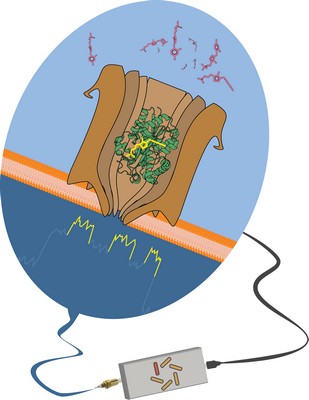Rapid measurement of vitamin concentration with nanopores
Scientists at the University of Groningen have developed a nanopore system that can measure the concentration of thiamine (vitamin B1) in urine in less than a minute by using an engineered thiamine binding protein. This system should also work with other bodily fluids such as sweat, and can be adapted to measure other molecules that are important for good health. Eventually, this could lead to a wearable device to measure important metabolites. A paper describing the system was published in the journal Angewandte Chemie on 14 August.
Many people use wearable health monitors that measure properties such as mobility, heart rate, blood pressure, and temperature. ‘It is much more difficult to monitor the body’s chemistry,’ say Giovanni Maglia, Professor of Chemical Biology and NWO Veni fellow Carsten Wloka of the University of Groningen Biomolecular Sciences and Biotechnology Institute. ‘To do this, you need a range of sensors which can transform the concentration of molecules into an electrical signal.’

Concentration
The Maglia laboratory has extensive experience in creating nanopores that can be used to identify specific molecules, and portable devices using nanopores are already on the market. Together with colleagues at the University of Groningen Department of Pharmacy, the researchers used the previously developed Cytolysin A nanopore to measure thiamine (vitamin B1) by using an engineered variant of the thiamine binding protein.
‘We used an engineered bacterial protein that binds thiamine. By applying a potential across the pore, the protein enters the pore,’ explains Maglia. ‘When it then binds thiamine, it changes its shape from an open to a closed configuration.’ This changes the electrical signal passing through the pore. By measuring the number of shape changes caused by the binding and release of thiamine in the nanopore system, it is possible to calculate the thiamine concentration. ‘PhD candidate Florian Lucas has developed software that can determine the concentration in about 20 seconds.’

Blood
In the Angewandte Chemie paper, the scientists show that this approach works in urine. Other fluids, such as sweat and probably blood, could also be analysed. Furthermore, the system could measure other molecules by using different binding proteins. ‘The pores can be integrated into existing nanopore devices, and we have created a start-up company to look further into a potential commercial application,’ says Maglia.
The idea is to include a range of proteins that bind different molecules, and to use this to monitor their concentrations in bodily fluids. The nanopore system could be linked to a wearable device such as a smartwatch to monitor these molecules, which would allow much more extensive health monitoring in real time, conclude Wloka and Maglia.
Reference: Florian Leonardus Rudolfus Lucas, Tjemme Rinze Cornelis Piso, Nieck Jordy van der Heide, Nicole Stéphanie Galenkamp, Jos Hermans, Carsten Wloka, Giovanni Maglia: Automated Electrical Quantification of Vitamin B1 in a Bodily Fluid using an Engineered Nanopore-Sensor. Angewandte Chemie First online 14 August 2021
| Last modified: | 31 August 2021 1.53 p.m. |
More news
-
10 June 2024
Swarming around a skyscraper
Every two weeks, UG Makers puts the spotlight on a researcher who has created something tangible, ranging from homemade measuring equipment for academic research to small or larger products that can change our daily lives. That is how UG...
-
21 May 2024
Results of 2024 University elections
The votes have been counted and the results of the University elections are in!

